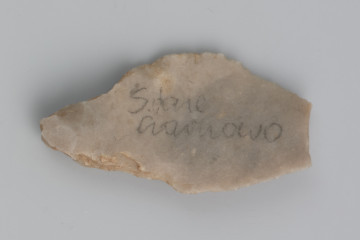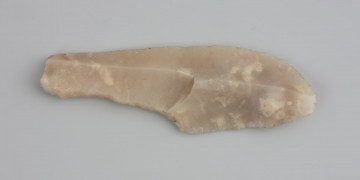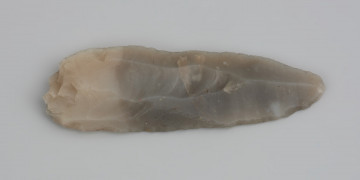
Swiderian tanged point
10800 p.n.e. — 9000 p.n.e.
National Museum in Szczecin
Part of the collection: Stone Age
The Bromme-type tanged point was found in the Krzekowo district in Szczecin in 1968. It was made on a short, elongated blade, a half-finished piece chipped off a larger lump of local Middle Turonian flint, as evidenced by the presence of bryozoans’ skeletons embedded in the flint mass. The preserved technical traces suggest that the so-called soft pestle of bone, antler or soft rock such as sandstone was used to break off the blade. The technique was characteristic of the Late Palaeolithic population representing the so-called Bromme culture. Bromme tanged points are - depending on their size - spearheads, javelins or arrows, used by prehistoric hunters to hunt moose, reindeer and perhaps the last representatives of the giant deer (Megaloceros), which was an endangered species at that time. They are characteristic of the Bromme culture, belonging to the circle of the so-called leaf cultures, whose representatives used the characteristic willow leaf-shaped arrowheads and arrowheads with distinct handles. In addition to the Bromme culture, hunter-gatherers inhabiting a forest environment, the Ahrensburg and Swiderian cultures belong to the same circle - hunters of the tundra, stepo-tundra and parkland tundra zones.
Michał Adamczyk
The Bromme-type tanged point was found in the Krzekowo district in Szczecin in 1968. It was made on a short, elongated blade, a half-finished piece chipped off a larger lump of local Middle Turonian flint, as evidenced by the presence of bryozoans’ skeletons embedded in the flint mass. The preserved technical traces suggest that the so-called soft pestle of bone, antler or soft rock such as sandstone was used to break off the blade. The technique was characteristic of the Late Palaeolithic population representing the so-called Bromme culture. Bromme tanged points are - depending on their size - spearheads, javelins or arrows, used by prehistoric hunters to hunt moose, reindeer and perhaps the last representatives of the giant deer (Megaloceros), which was an endangered species at that time. They are characteristic of the Bromme culture, belonging to the circle of the so-called leaf cultures, whose representatives used the characteristic willow leaf-shaped arrowheads and arrowheads with distinct handles. In addition to the Bromme culture, hunter-gatherers inhabiting a forest environment, the Ahrensburg and Swiderian cultures belong to the same circle - hunters of the tundra, stepo-tundra and parkland tundra zones.
Michał Adamczyk
Author / creator
Dimensions
cały obiekt: height: 5 cm, width: 1.9 cm
Object type
tanged point, arrowhead
Technique
carving, peeling, soft masher carving
Material
flint, stone
Origin / acquisition method
donation
Creation time / dating
Creation / finding place
Owner
National Museum in Szczecin
Identification number
Location / status

10800 p.n.e. — 9000 p.n.e.
National Museum in Szczecin

11900 p.n.e. — 11000 p.n.e.
National Museum in Szczecin

11900 p.n.e. — 11000 p.n.e.
National Museum in Szczecin
DISCOVER this TOPIC
National Museum in Lublin
DISCOVER this PATH
Educational path